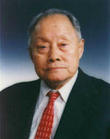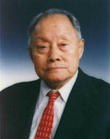

 Wang You (1910.06-1997.05), also known as Yu WANG, was a native of Hangzhou, Zhejiang province. He was a Chinese chemist and biochemist. He was a pioneer of antibiotics and biochemistry studies in China. He first studied applied chemistry at Zhejiang University. Later he went to Nanjing and graduated from Department of Industrial Chemistry, Jinling University in 1931. He obtained his PhD from the Ludwig Maximilian University of Munich in 1937. Between Nov 1952 and Jul 1984, chronologically, Wang was the deputy director, acting director, director (later the honorary director 1984-1997) of Shanghai Institute of Organic Chemistry, Chinese Academy of Science, which was the most prestigious institute for organic chemistry research in China. He was elected academician of Chinese Academy of Sciences in 1955. He was also foreign member of French Academy of Sciences and Bavarian Academy of Sciences and Humanities, and honorary member of American Society for Biochemistry and Molecular Biology
Wang You (1910.06-1997.05), also known as Yu WANG, was a native of Hangzhou, Zhejiang province. He was a Chinese chemist and biochemist. He was a pioneer of antibiotics and biochemistry studies in China. He first studied applied chemistry at Zhejiang University. Later he went to Nanjing and graduated from Department of Industrial Chemistry, Jinling University in 1931. He obtained his PhD from the Ludwig Maximilian University of Munich in 1937. Between Nov 1952 and Jul 1984, chronologically, Wang was the deputy director, acting director, director (later the honorary director 1984-1997) of Shanghai Institute of Organic Chemistry, Chinese Academy of Science, which was the most prestigious institute for organic chemistry research in China. He was elected academician of Chinese Academy of Sciences in 1955. He was also foreign member of French Academy of Sciences and Bavarian Academy of Sciences and Humanities, and honorary member of American Society for Biochemistry and Molecular Biology
Wang had won a number of awards for his outstanding achievements: State Natural Science Awards, First Class for total synthesis of cattle insulin and of yeast alanine transfer ribonucleic acid; State Natural Science Awards, Second Class for research on chemical and space structures of Trichotomine; CAS Significant Science and Technology Award, First Class for petroleum yeast and protein feeds; CAS Preeminent Science and Technology Award, Second Class for acyl imidazole's application in ribonucleotide acylation; National Science Conference Award for new-type plasma--carboxyalkyl amylase; CAS Significant Science and Technology Award for in-depth dewaxing by petroleum fermentation.
TOTAL SYNTHESIS OF YEAST ALANINE TRANSFER RIBONUCLEIC ACID
Wang Debao
(Shanghai Institute of Biochemistry, Chinese Academy of Sciences)
Abstract
Yeast alanine transfer ribonucleic acid (tRNAy(Ala)) consists of 76 nucleotides. In addition to the 4common nucleotides, A, G, C and U, this tRNA contains 9 modified nucleotides of 7 different species, m1G, D, m22G, I, m1I, and T. By a combination of chemical and enzymatic methods, small oligonucleotides with lengths varying from 2 to 8 nucleotides were synthesized from mononucleotides and nucleosides. The small oligonucleotides were then phosphorylated at the 5'-end with adenosine triphosphate (ATP) in the presence of polynucleotide kinase and the 5'-phosphorylated oligonucleotides were used as donors. Donors and suitable acceptors, oligonucleotides with 3'- free hydroxyl group, were ligated by T4 RNA ligase into 6 large oligonucleotides of 13, 9, 13, 10, 12 and 19 nucleotides in lengths. These oligonucleotides were further phosphorylated at their 5'-ends and ligated to form two half molecules with 35 and 41 nucleotides respectively. Finally, the two half molicules were again phosphorylated at their 5'-ends, annealed and ligated to obtain the whole molecules of tRNAy(Ala). Prior to this, two semisyntheses were performed, i.e. ligation of the synthetic 5'-half molecule with the natural 3'-half molecule and that of the natural 5'-half molecule with the synthetic 3'-half molecule.
Both the semi-synthetic tRNAy(Ala) and the synthetic tRNAy(Ala) occupy the same position as the natural tRNAy(Ala) after electrophoresis on a 20% polyacrylamide gel. They have the same chemical composition (containing 9modified nucleotides of 7different species) and structure as the natural tRNAy(Ala) and are biologically active, i.e. accepting and transferring alanine into proteins in a cell-free protein synthesizing system, the accepting activity of the synthetic product is 52-66%of that of the natural tRNAy(Ala) and 91-106% of that of the reconstituted product of the two natural half molecules. The incorporation activity of alanine into proteins of the synthetic 3H-alanine tRNAy(Ala) is 63%, corresponding to 91% of that of the natural tRNAy(Ala) and 115%of that of the reconstituted product of the two natural half molecules.
Both common and modified nucleotides and nucleosides, protecting and condensing reagents for chemical synthesis and enzymes for enzymatic synthesis and biological activity tests were all prepared.
To the best of our knowledge, this is the first time that a natural RNA with biological activity is synthesized.